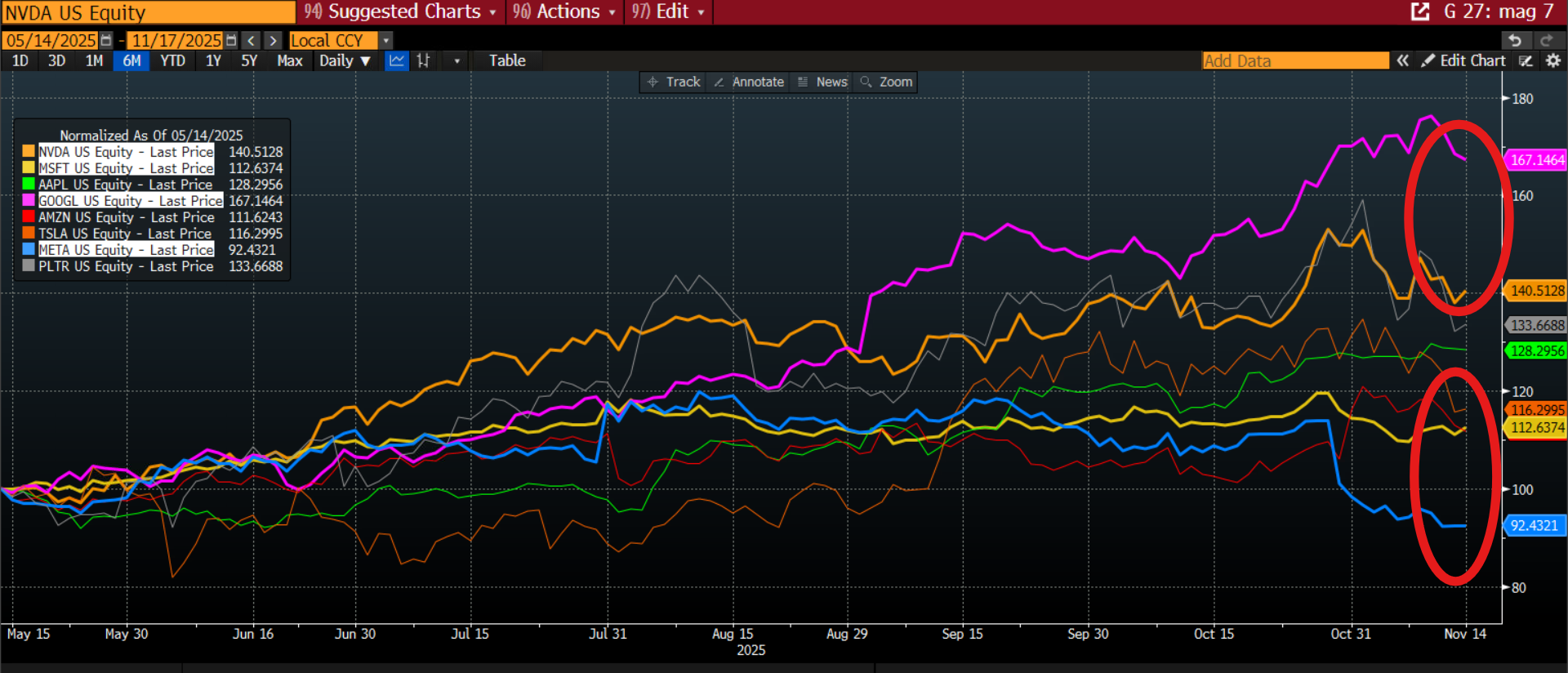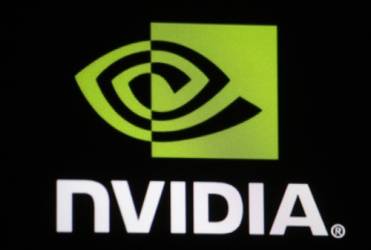- November’s seasonality yet to kick in
- Fed fears spook markets
- UK’s reliance on forecasts determining fiscal policy, triggers bond market volatility
- Can Nvidia save tech?
- Investors to scrutinize AI spend
- Shifting fortunes for the Magnificent 7
- UK CPI
- US: when will the data restart happen?
- Nvidia results
- November’s seasonality yet to kick in
- Fed fears spook markets
- UK’s reliance on forecasts determining fiscal policy, triggers bond market volatility
- Can Nvidia save tech?
- Investors to scrutinize AI spend
- Shifting fortunes for the Magnificent 7
- UK CPI
- US: when will the data restart happen?
- Nvidia results
At the start of a new week, the market mood has calmed. US stock futures are pointing to small gains later on Monday, after a sharp sell off on Friday, European stock index futures are mostly flat at the start of the week.
The next few days could be key for long term direction of stocks and how they perform into year end. Later this week we will get long-awaited data releases from the US, which will be key to determining if the Fed cuts interest rates next month. We also get Nvidia’s results on Wednesday, which could revitalize the AI/ big tech trade.
As we have mentioned in the past, a pattern is developing as we move into the end of the year. On average, stocks have tended to sell off at the end of the week, with markets bouncing back again on Monday, so we will be looking to see if there is a recovery at the start of this week.
November’s seasonality yet to kick in
November is shaping up to be a tough month for risky assets. This is normally a seasonally strong month for global stocks, the average November return for the S&P 500 over the past 5 years has been 5.59%. So far this month, the Nasdaq is lower by 3.5% and the S&P 500 is down more than 1.5%. Japanese stocks have also old off heavily so far this month, while Europea stocks are outperforming so far.
Fed fears spook markets
While it should be a seasonally strong period for stocks, the list of concerns for investors keeps getting longer. The first is the Fed. Investors had been pricing for a rate cut from the Fed before year end, however, the doves have disappeared. There is now less than a 50% chance of a Fed rate cut by year end, this had been a near certainty a month ago.
The reason for the re-pricing of Fed rate cut expectations is that we remain in a US data vacuum. There will be a delay to economic data releases, and chances are growing that the Fed will avoid changing monetary policy when the economic outlook remains murky. Added to this, it does not look like the US government will get back to normal as quickly as some expected. Paychecks are still delayed, and flights may take some weeks to return to normal, which could weigh on growth especially as we are two weeks away from Thanksgiving and Black Friday.
UK’s reliance on forecasts determining fiscal policy, triggers bond market volatility
Bond market volatility has picked up in Japan and the UK, as the bond market’s good will towards highly indebted and spendthrift governments is reversed. UK bond yields soared on Friday, especially at the long end of the curve, after Chancellor Rachel Reeves reversed course on plans to raise income tax. This should be good news for markets, since the UK is a service-based economy that is reliant on a buoyant consumer, however, the reason for the reversal was another OBR forecast, which gave £10bn of extra headroom to Reeves and allowed her to chance course.
This is far from reassuring for markets for two reasons: 1, it shows that UK fiscal policy remains highly reliant on OBR forecasts, which can be wrong. 2, if the Chancellor tries to milk taxpayers by raising hundreds of small taxes, without making public spending sustainable, especially for benefits and welfare, then the chances are that she will have to come back for yet more tax increases next year.
The Budget takes place next week, the Treasury would be wise to halt all media updates and leaks about potential tax and spend changes before then, especially since the UK bond market remains fragile. UK long end yields sold off sharply on Friday, the 30-year Gilt and the 10-year Gilt were the worst global performers at the end of last week.
Can Nvidia save tech?
One of the biggest themes for markets remains the tech stock sell off. The volatility that rocked financial markets at the end of last week, was led by a rotation out of high beta stocks, which tend to experience higher swings both to the upside and the downside, and into more stable sectors of the market. This meant that tech, communications and consumer discretionary, which are all high beta plays, were sold off, while the energy and utility sectors outperformed, as these tend to be more defensive plays. Financial stocks also had a stronger relative performance as reduced rate cut expectations can help to boost banks’ net interest income.
Investors to scrutinize AI spend
The question now is, is the sell off in tech stocks justified? Valuations, particularly for AI stocks, seems to be a theme that is puncturing the stock market rally as we move through November. There could be some long-term damage done after a sharp sell-off saw Oracle’s share price drop nearly 30% this month. The market may fundamentally look at AI infrastructure spending differently from now on, after analysts noted that the planned AI infrastructure build out could cost $5 trillion. The issue is that the biggest hyperscalers including Microsoft, Alphabet, Meta, Amazon and Oracle, ‘only’ have $350bn in the bank. Big tech using their free cash flow along with debt to fund their AI dreams is new territory for the tech trade. Investors have been used to the tech sector hoarding cash and becoming more stable than some large western economies. However, all of that is about to change.
Now big tech are selling bonds to fund their AI plans, which means that investors will need to look more closely at their balance sheets than ever before. Oracle, Coreweave and Meta have sold tens of billions of dollars’ worth of debt in recent weeks, which has led to a widening in their bond spreads with Treasuries, as investors have woken up to the fact that some of the hyperscalers will need to issue much more debt over the coming years to fund their AI plans. Added to this, credit default swaps are also reflecting the newfound risks for some tech stocks. For example, the cost of insuring Oracle’s debt has doubled since September.
Shifting fortunes for the Magnificent 7
This helps to explain the divergence in the Magnificent 7. As you can see below, all of the Magnificent 7 stocks have come under pressure in the recent sell off, however, Microsoft and Meta are the lagging performers YTD, while Google, Apple and Nvidia are outperforming. Apple, who has shunned extreme AI investment plans, is looking stable compared to Meta et al, and this stock could outperform into year end.
Chart 1: Magnificent 7 YTD performance

Source: XTB and Bloomberg
The market is becoming more discriminating when it comes to tech stocks and the AI trade, which could limit growth stocks as we move into year end. However, this is a good thing and it makes the AI theme safer, as it reduces the chance that tech stocks will become a bubble needing to be popped.
Below, we look at three events that could shift the dial for financial markets.
1, UK CPI
This will be a crucial data release as it could determine whether the Bank of England cuts interest rates next month. There is currently a 69% chance of a cut, with many expecting the decision to be another close call.
The market is expecting the October inflation data to support calls for a rate cut. The headline rate of CPI is expected to moderate to 3.5% from 3.8%. The core rate of price growth is also expected to fall to 3.4% from 3.5%, and the rate of service inflation is expected to moderate to 4.6% from 4.7%.
This is still well above the BOE’s target rate, however, crucially inflation in September did not reach the BOE’s expected peak of 4%, which means that price growth could be downhill from here.
The CPI data could add to evidence that the UK economy is decelerating quickly, after a jump in the unemployment rate and negative GDP for September. A weaker than expected CPI reading for last month could trigger another bout of weakness in the pound. GBP sold off last week as bond yields jumped. The pound was the second weakest currency in the G10 FX space. However, interestingly, GBP/USD managed to stay bid above $1.31, even with budget speculation and the weak growth outlook, GBP/USD has not fallen below $1.30, a key psychological level for this pair. Unless we see a large downside surprise for CPI this week, then the pound could be range bound as we lead up to the budget.
2, US: when will the data restart happen?
This is the big question for all investors. There is a chance that the September jobs report could be released this week, however, at this stage that is yesterday’s news, and we do not expect it to have a long term impact on market sentiment. Instead, the market may focus on the FOMC minutes, which may show continued caution when it comes to easing monetary policy before year end, after a number of Fed members have said that the economy remains strong.
The Fed cut rates at its October meeting, however, the chair Jerome Powell, struck a hawkish tone, which rattled financial markets and led to doubts about the potential for a December rate cut. Currently there is a 42% chance of a rate cut from the Fed next month, which means that the tone of these minutes could shift the dial for the Fed Fund Futures market. If the minutes do strike a hawkish tone, then they may hurt risk sentiment further.
3, Nvidia results
Nvidia, along with other tech stocks bounced back on Friday, however, the stock has had a lacklustre performance in recent weeks. The question is, can its latest earnings report revitalize the AI trade and help tech stocks as we move into year end?
Nvidia is seen as the AI bellwether because it controls most of the GPU trade. The chips that it makes are crucial components for data centres worldwide and its biggest customers are Microsoft and Meta, who remain committed to spending on their AI capabilities. This is good news for Nvidia, and it is why we expect their results to be beat expectations later this week.
Analysts are expecting another monster report. Nvidia is expected to report revenues of $55.14bn for last quarter, and net income of $30.8bn. These could be ‘perfect’ results, with future earnings guidance also expected to be strong, as the GB3000 sees demand accelerating, and hyperscalers committing billions of dollars in AI investment into 2026. Gross margin remains in focus and this is expected to be strong, as margins improve as production of its latest chips, the Blackwell and the Ruben, is more efficient. The market is looking for gross margin somewhere in the 70-75% range, and if Nvidia suggests that extra supply could come on board then this could boost investor sentiment further.
Nvidia is set to affirm that the Blackwell and Reuben chips will reach $500bn in cumulative revenues. This is a monster number, and one that investors could cheer. Sovereign programs and continued strong demand from non-cloud service producers could offset fears about China, which remains effectively offline.
Overall, this report could suggest that Nvidia is not only central to the entire AI project, but it is also so cash-generative and successful it may be lead to investors taking a fresh look at the AI trade. We continue to think that hyperscalers’ share prices will lag AI capex beneficiaries like Nvidia’s for some time, as we mention above. However, if Nvidia gives a positive outlook, then it could lift the entire tech sector later this week.
Chart of the day: USDJPY (17.11.2025)
Crypto news: Bitcoin tries to stop the sell-off 📌ETFs net outflows pressure crypto
Daily summary: Wall Street tries to stop the sell-off 📌Gold down 1.8%, Bitcoin loses 4.5%
Wheat drops amid higher than expected WASDE report
This content has been created by XTB S.A. This service is provided by XTB S.A., with its registered office in Warsaw, at Prosta 67, 00-838 Warsaw, Poland, entered in the register of entrepreneurs of the National Court Register (Krajowy Rejestr Sądowy) conducted by District Court for the Capital City of Warsaw, XII Commercial Division of the National Court Register under KRS number 0000217580, REGON number 015803782 and Tax Identification Number (NIP) 527-24-43-955, with the fully paid up share capital in the amount of PLN 5.869.181,75. XTB S.A. conducts brokerage activities on the basis of the license granted by Polish Securities and Exchange Commission on 8th November 2005 No. DDM-M-4021-57-1/2005 and is supervised by Polish Supervision Authority.


